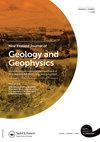新西兰奥塔哥中部高ph盐田的地球化学演化
IF 1.9
4区 地球科学
Q1 GEOLOGY
New Zealand Journal of Geology and Geophysics
Pub Date : 2022-05-19
DOI:10.1080/00288306.2022.2076701
引用次数: 2
摘要
本文章由计算机程序翻译,如有差异,请以英文原文为准。
Geochemical evolution of high-pH sodic salt pans in Central Otago, New Zealand
ABSTRACT
Soil-free sodic salt pans with local pH >10 have formed on loess and schist-derived clay surfaces in the semi-arid climate of Central Otago. This study identifies evaporative mineral distributions and associated variations in surface geochemistry, and these results are relevant to survival of rare halophytic plants on some of the pans. Evaporative salts on pan surfaces are dominated by NaCl from marine aerosols, and Na-sulphates and Na-carbonates. Some of the Na in evaporites was derived from alteration of schist-derived albite and Na-bearing smectite formed from albite. The high pH pan surfaces result from a combination of long-term (decades to millennia) albite alteration and short-term (minutes to months) Na-carbonate dissolution and recrystallisation. This muscovite is variably cemented by evaporative salts, and some crusts have abundant salt-dissolution voids. High pH has facilitated dissolution of aluminium and silica from albite and smectite, with evaporative precipitation of Al-oxyhydroxide contributing to crust cementation. Different dissolution rates of evaporative minerals during rain events and damp seasons results in differential mobility of salt components downslope. The salt pans are physically and chemically dynamic features that have formed on time scales of decades to centuries.
求助全文
通过发布文献求助,成功后即可免费获取论文全文。
去求助
来源期刊
CiteScore
5.10
自引率
27.30%
发文量
34
审稿时长
>12 weeks
期刊介绍:
Aims: New Zealand is well respected for its growing research activity in the geosciences, particularly in circum-Pacific earth science. The New Zealand Journal of Geology and Geophysics plays an important role in disseminating field-based, experimental, and theoretical research to geoscientists with interests both within and beyond the circum-Pacific. Scope of submissions: The New Zealand Journal of Geology and Geophysics publishes original research papers, review papers, short communications and letters. We welcome submissions on all aspects of the earth sciences relevant to New Zealand, the Pacific Rim, and Antarctica. The subject matter includes geology, geophysics, physical geography and pedology.

 求助内容:
求助内容: 应助结果提醒方式:
应助结果提醒方式:


